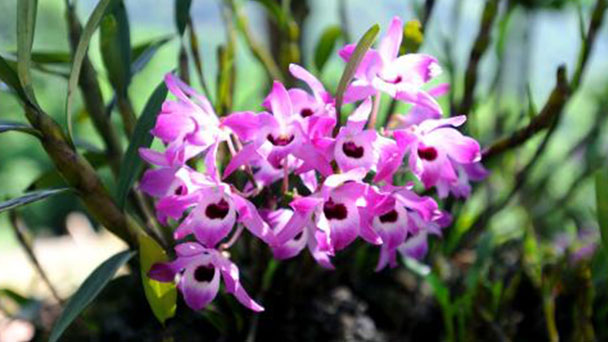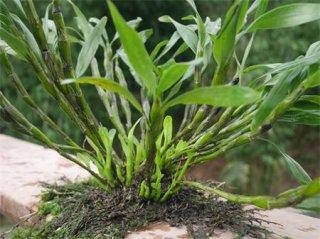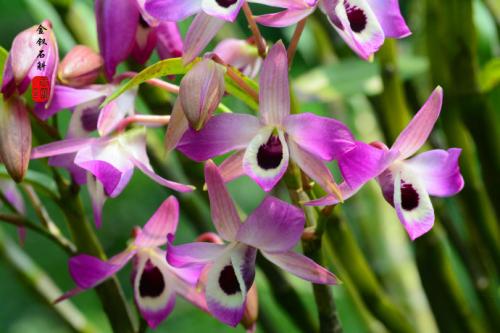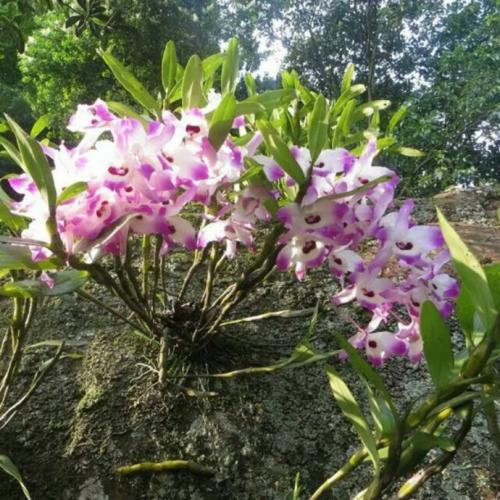Dendrobium nobile profile
Written by Maggie
Mar 02 2021

Dendrobium nobile stems are fascicular, upper slightly flat and slightly curved upward, 10~60 cm high, up to 1.4 cm thick. Dendrobium nobile likes to grow in a warm, moist, half - shade and half - light environment.
Dendrobium is mainly native to tropical and subtropical Asia, Australia and the Pacific Islands. There are about 1000 species of Dendrobium worldwide. There are about 76 species in China, most of which are distributed in Southwest China, South China and Taiwan. Dendrobium nobile is the largest genus in the orchid family. Dendrobium nobile has the effect of nourishing Yin and clearing heat, generating fluid and quenching thirst. It is used for the treatment of fever injury and fluid, thirsty tongue dryness, and deficiency heat after disease.
Dendrobium nobile picture

Morphological characteristics of Dendrobium nobile
Stems
Stem of Dendrobium nobile is erect, fleshy hypertrophic, slightly oblate cylindrical, 10~60 cm long, up to 1.3 cm thick, more or less oblate curved upper part, base obviously narrow, unbranched, with many nodes, nodes sometimes slightly swollen; Internodes are more or less inverted conical, 2~4 cm long, golden yellow after dry.
Leaf
Leaves of Dendrobium nobile are leathery, oblong, 6 -- 11 cm long and 1 -- 3 cm wide, apex obtuse and equilaterally 2-lobed, base with an operculating sheath.
Flowers
Racemes of Dendrobium nobile are from above middle of leaved or leafless old stems, 2 to 4 cm long, with 1 to 4 flowers; Pedicle is 5 -- 15 mm long, base by several tubular sheaths; Bracts are membranous, ovate-lanceolate, 6 -- 13 mm long, apex acuminate; Pedicels and ovaries of Dendrobium nobile are lavender, 3 -- 6 mm long; The flowers are large, white with lavender apex, sometimes all lavender red or except for a purplish patch on the labial disc, the rest are white; Middle sepals are oblong, 2.5 -- 3.5 cm long, 1 -- 1.4 cm wide, apex obtuse, with 5 veins; Lateral sepals of Dendrobium nobile are similar to middle sepals, apex acute, base askew, with 5 veins; Calyx sac conical, 6 mm long; Petals are more or less obtricose ovate, 2.5 -- 3.5 cm long, 1.8 -- 2.5 cm wide, apex obtuse, base short clawed, entire, with 3 main veins and many branches; Labellum of Dendrobium nobile is broadly ovate, 2.5~3.5 cm long, 2.2~3.2 cm wide, apex obtuse, base on both sides with purplish red stripes and narrow into short claws, the lower two sides of the middle surrounded by the core column, margin with short eyelashes, covered with short villi on both sides, with a purplish red large patch in the center of the labial disc; Stamen of Dendrobium nobile is green, 5 mm long, slightly enlarged at base, with green stamen legs; Medicinal cap is purplish red, conical, densely covered fine papillae, front edge with irregular teeth.
Ecological habits of Dendrobium nobile
Dendrobium nobile has strict requirements on the natural growing environment, such as the atmosphere, soil and water quality. It is afraid of cold, fond of high temperature and humidity, and strict on warm and humid climate. The annual average temperature is higher than 18℃, the winter temperature is higher than 3℃, and the frost-free period is more than 350 days. According to the planting resources survey of Chinese medicinal materials, only Chishui in Guizhou Province meets the planting conditions of Dendrobium nobile in the field.
The distribution region of Dendrobium nobile
Dendrobium nobile mainly Chishui, from part and sichuan luzhou area, which is especially in guizhou chishui Dendrobium nobile is preferred, in March 2006 by aqsiq approved chishui Dendrobium nobile for national geographical indication protection products, geographical indication protection at the same time imposes strict planting process and growth environment, temperature, humidity, altitude, PH value and a series of parameters, visible chishui Dendrobium nobile precious.
How to grow and care for Dendrobium Nobile
How to grow Dendrobium nobile
Site
Dendrobium nobile is a kind of symbiosis. It likes dark and humid environments. It requires high air humidity and broad-leaved sparse forest for shade. Ficus Virens, Ficus Virens, Ficus Virens and other trees with thick bark, longitudinal grooves, luxe leaves and thick trunk are attached to the live trees.
Seed selection and treatment
In the process of seed selection, the stump seedlings and tissue culture seedlings of Dendrobium nobile, which are free from disease, insect harm and mildew, should be selected for production. The seedlings can also be used to grow roots and buds on the middle and upper stem nodes of Dendrobium nobile to form new plants (with seedling stems, farmers call it "long holding column"). By all means avoid the harm of diseases and insects and harvest time and dry rotten mildew as a seed for expanding production, otherwise it will bring great losses to production. Seedlings are divided into stump according to the situation of seedling source, with sufficient seedling source, 5-8 seedlings per nest, and 2 ~ 3 seedlings per nest or single plant or seedling with stem for lack of seedling source.
The cultivation time
The best planting methods for Dendrobium nobile were spring and autumn. Practice has proved that spring planting is better than autumn planting. This is mainly to make full use of plant dormancy, the accumulation of organic nutrients, the climate rebound, the wind and the sun warm, all things recovery of the golden season, temperature and humidity, sunshine, rain conducive to Dendrobium rapid germination. Autumn planting is to take advantage of the suitable temperature of autumn (take advantage of the special climate of "Indian summer"). After all the preparation work before planting, we can choose the best planting season to develop Dendrobium production.
The cultivation method
Stone sticking method: the base of the scientifically treated nest seedlings is attached to the stone, and then the roots are fixed firmly on the surface of the stone with thread clip. Then the roots of Dendrobium nobile are covered with decomposed cow dung and moss, and the tender buds are raised with a density of 30cm×30cm.
Stick tree method: choose the tree stem relatively bulky too many deep grooves, hardwood [such as yellow Jue, tallow tree (commonly known as paper), the persimmon tree, seed of tung tree tree, etc.], in the trees in the rain, in the flat with a knife and cut a shallow thick branches or trunk tear, will have to deal with good caulis dendrobii, with bamboo nail or rope to fix base on the segments, and then use cow dung: mud apply to the caulis dendrobii root (5:1).The density of tree sticking cultivation is generally 30 ~ 40 cm in a nest. In order to prevent wind blowing and rain washing, two laps should be bundled to fix the roots on the trunk or tree branches, so that the new roots can grow closely along the tree body.

How to care for Dendrobium nobile
Temperature and light care
The suitable growth temperature of Dendrobium nobile is 15~28℃, so it is necessary to build a suitable temperature environment for its growth. When the temperature is high in summer, ventilation and heat dissipation should be strengthened in the facility greenhouses. The temperature in the greenhouses should be controlled within an appropriate range by means of shading shed, spray cooling and ventilation cooling.When the temperature is low in winter, the facility greenhouses should be well sealed. When necessary, the temperature in the facility can be increased by various heating methods to prevent frostbite plants.
Dendrobium nobile likes shade, so shading measures should be adopted to reduce the illumination. The shading degree of Dendrobium nobile in the growing period is about 60%. When seedlings have just finished planting, greenhouses should be covered with shading nets above 70% shading degree to prevent strong light exposure from causing seedling wilting and affecting the survival rate. In the summer and autumn of high temperature and high intensity light, the shade net of the greenhouse must be covered well and firmly, because the high intensity light is easy to make the plant top early, and the growth is not high, which affects the yield. Winter should be appropriate to uncover shade shed for light, extend the growing period.Stick to the tree cultivation (attached to the main cultivation), should be in each winter, spring season appropriate cut to attach to the main plant too dense branches.
Moisture and humidity care
Water management is one of the key steps in the cultivation of Dendrobium nobile. The newly transplanted Dendrobium nobile seedlings are the most sensitive to water. At this time, it is generally appropriate to control the moisture content of the substrate at 60%~70%, and it is appropriate to hold the substrate with a wet feeling but no dripping during the specific operation. Within 7 days after transplanting (seedlings have not yet developed new roots), the air humidity was maintained at about 90%. After 7 days, the plants began to develop new roots, and the air humidity was maintained at 70%~80%. In summer and autumn, the moisture content should be controlled as much as possible, and the substrate moisture content should be 40%~50%. In the winter, the temperature drops gradually. When the temperature is below 10℃, Dendrobium nobile basically stops growing and enters dormancy state. At this time, the water content of the matrix should be controlled within 30%. Overwintering is mainly heat preservation, measures add two film, smoke antifreeze, artificial heating and so on. Dendrobium nobile should be treated with anti-freezing exercise and proper humidity reduction before winter. Water should be sprayed once every 15 days.
Potting care
DDendrobium nobile is an epiphytic plant, which means that in nature, they grow attached to other plants, rather than in soil. For this reason, you should ensure that your dendrobium nobile orchid is potted in a very well aerated and well-draining potting mix.
A good quality pre-prepared orchid mix will be ok, or you can make your own. An equal mix of coarse pine bark, coconut husk and perlite is a mix that I use very successfully with a number of orchid species.
Pruning care
After your DDendrobium nobile has finished flowering, you should trim the flower spikes off close to the cane. Do not cut a cane that has finished flowering, as an individual cane can rebloom the following year, but they also contain a store of energy which the plant can use to grow new canes and vegetative growth, leading to bud and bloom development on a new cane.
Harvest
The harvest of Dendrobium nobile can be carried out throughout the year, and it is usually suitable to harvest in winter. The determination method of harvesting stem, every year in winter, more than two years of stem, leaf began to turn yellow, some began to fall leaves, signs have matured. Harvesting is done by cutting off the old plants from the base of the stem with scissors or sickles, leaving the tender plants to continue to grow, to be managed, and to be picked again the following year. So-called a year of planting, many years of benefit lies in this.
Dendrobium nobile disease and pest control method
Dendrobium nobile disease:
(1) Rot: also known as bacterial leaf spot disease, mostly from the source of infection, may also occur in the leaves, the main water soaked dark green spots, gradually expand softening brown rot rot parts have secretions outflow, accompanied by the smell. Bacteria can be spread through water. High temperature and high humidity are conducive to the occurrence of the disease. Once the infected plants are found, they should be isolated and destroyed in time, and be prevented with streptomycin, Bordeaux liquid, methyl parathion and other drugs.
(2) Black spot: Dendrobium nobile is a major disease hazard to the location of the blade. After enlargement, the lesions were nearly round. The central part of necrotic lesions was yellowish brown with a diameter of 0.5-1.0 cm. Severe episodes in which the lesion is joined together, causing the yellow leaves to fall off.
Dendrobium nobile pest:
(1) Aphids: They mainly harm young leaves and buds of Dendrobium nobile, so as to absorb nutrients through sucking plant juice epidermis, causing leaves and buds to wilt and deform, but can also lead to invasive diseases. Prevention and control methods: strengthen ventilation, improve the cultural environment, combined with spraying, can be used 20% cyanvalerate 1500 times liquid, 40% oxidized diethoate 1000 times liquid spray control.
(2) Scale insects: common pests in Dendrobium nobile planting, mainly parasitic on the back of leaves or sheath. It occurs in low humidity, poor ventilation environments. Early damage leaves yellow, photosynthesis, plant death or severe failure to grow and flower normally.In addition to strengthening ventilation, a small amount can be removed with a soft brush. Drug prevention and treatment, using 50% or 25% malathion scale death net 800-1000 times, spray once a week, continuous spray 3?4 times.
(3) Snails and Slugs: Long wet or rainy seasons are common. Dendrobium nobile bite, climbs out or bud tip at night, causing serious growth disruption. You can remove weeds and moss from the ground; Small amounts of night hunting or artificial surface with lime corner killing events; Use an 80% or 90% discount snail psychic trichlorfon drug when large areas appear to be treated.
Dendrobium nobile main value
Anti-aging, improve immunity
Dendrobium nobile Orchid can significantly increase the level of superoxide dismutase (SOD), reduce lipid peroxide (LPO), regulate the level of brain monoamine neuromediators, inhibit similar monoamine oxidase (MAO), and play a role in anti-aging. In recent years, Dendrobium polysaccharide, which has attracted much attention, also has significant immune-enhancing activity, anti-aging, anti-radiation and other functions.
Activate blood circulation and remove blood stasis, improve cardiovascular and cerebrovascular function
Dendrobium nobile orchid contains esters, which has the functions of promoting blood circulation, removing blood stasis, dilating blood vessels and anti-platelet coagulation, as well as treating thromboangiitis obliterans, cerebral thrombosis and arteriosclerotic occlusion. Mailuoning injection, extracted and processed from Dendrobium and honeysuckle, has functions such as clearing heat and nourishing Yin, promoting blood circulation and removing blood stasis.
Antitumor
The phenanthrene and tribenzyl compounds extracted from Dendrobium nobile orchid have anti-lung cancer, ovarian adenocarcinoma and premyeloid leukemia. Dendrobium nobile can promote the growth of T cells and lymphocytes to produce inhibitory factors, play a role in enhancing immunity. The ethyl acetate extract of Dendrobium nobile has significant cytotoxic effects on human lung cancer cells, human ovarian adenocarcinoma cells and human promyelocytic leukemia. In particular, Dendrobium nobile had a great inhibitory effect on lung cancer cells, and the inhibitory rate was as high as 74.7%-97.2%. Two compounds, Lusianthridin and denbinobin, were isolated and identified from the crude extract of Dendrobium officinale, which had the same pharmacological effects as the crude extract, and the former also had an inhibitory effect on transplanted sarcoma S-180.
Treat digestive system diseases
Dendrobium nobile can stimulate the intestinal tract and increase the contraction amplitude. Pharmacological tests showed that Dendrobium nobile decoction could promote gastric juice secretion and help digestion. Dendrobium nobile extract can stimulate the contraction of small intestinal smooth muscle and promote gastrointestinal peristalsis.T o chronic atrophic gastritis can receive a unique, satisfactory effect.
Treatment of eye disease
Dendrobium dendrobium has obvious therapeutic effect on ophthalmic diseases. Dendrobium nobile not only has inhibitory effect on galactose cataract, but also has certain therapeutic effect. The percentage of Dendrobium nobile retaining lens is 36.8%.In the treatment of cataract, it can inhibit and correct the abnormal changes of enzyme activity caused by galactose, and also prevent or correct the imbalance of total lipid and total cholesterol in the lens caused by galactose cataract. The main "Qingjing Powder" in the traditional Chinese medicine section is composed of Dendrobium and Ophiopogonis, which has the effect of nourishing Yin and radiating heat, clearing wind and clearing heat, dredging collaterals and dispersing nodes, and retreating the eye. Dendrobium nobile is used in combination with pterygium excision and corneal transplantation with good effect. "Dendrobium Night Light Pill" is composed of 25 Chinese medicinal materials such as Dendrobium and Ginseng, which has a good effect on the treatment of cataract, glaucoma and optic neuritis.

Latest Updated
- Benefits of Bugleweed - 7 Science-backed Health Benefits
- Bugleweed Dangers & Side Effects - Is It Poisonous?
- How to Plant Evergreen Trees - What You Should Know
- When to Plant Evergreens - Grow Guide for Evergreen Trees
- 12 Wonderful Evergreen Shrubs for Your Garden
- 12 Popular Evergreen Plants with Pictures for Beginners
- When And How To Prune A Lilac Bush Like a Pro
- How to Grow & Care for Lilac Vine (Hardenbergia Violacea)
- Japanese Lilac Tree (Syringa Reticulata) Care & Propagation Guide
- Shumard Oak Pros and Cons - What to Know
Popular Articles
- Winter maintenance of Antirrhinum Majus
- How to Grow Terminalia Mantaly Tree
- How to Grow and Care for Crossostephium Chinense
- How to grow Antirrhinum Majus in spring
- Peristeria Elata (Dove Orchid) Profile: Info & Care Guide
- Underwatered Snake Plant (Sansevieria Trifasciata) - Signs And How To Fix
- How to Care for Brazilian Jasmine Plant (Mandevilla Sanderi)
- How to Grow & Care for Graptopetalum Purple Delight in Summer
- Rosa Chinensis (China Rose): Plant Growing & Care Tips
- How to Care for Baby Sun Rose (Aptenia Cordifolia)